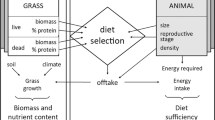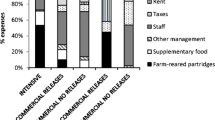Abstract
There has been a rapid increase in the number of private game ranches established in South Africa in recent years. These ranches are good for conservation but many are driven by the profit motive. A number of models have been used to help managers formulate strategies for achieving their economic objectives. These models are discussed and their use illustrated.
A detailed sex and age structured model is presented first with an illustration of its use in attaining two different management objectives. For a given management objective this model generates the returns per unit of food consumed for each species. These returns are then fed into a model to determine the relative abundance of each species in a multispecies herbivory that is required to maximise income.
Finally, some problems with the use of these models are discussed. Suggestions and current modelling activities towards improving the tools available to African game ranch managers are presented.
Similar content being viewed by others
References
G.W. Arnold, Influence of the biomass, botanical composition and sward height of annual pastures on foraging behaviour by sheep, Journal of Applied Ecology 24 (1987) 759–772.
J.I. Barnes and J.L.V. de Jager, Economic and financial incentives for wildlife use on private land in Namibia and the implications for policy, South African Journal of Wildlife Research 26(2) (1996) 37–46.
J.R. Beddington and D.B. Taylor, Optimum age specific harvesting of a population, Biometrics 29 (1973) 801–809.
J. du. P. Bothma, Game Ranch Management, 3rd edn (completely revised and expanded) (J.J. van Schaik, Pretoria, 1996).
J.E. Danckwerts. and R.H. Drewes, Stocking rate and carrying capacity, Department of Agriculture and Water Supply, Pretoria (1989).
T. Eloff, Farming with a future, Game and Hunt 2/3 (1996) 21, 23–24.
A.A. Ferrar, Guidelines for the management of large mammals in African conservation areas, South African National Scientific Programmes Report 69 (1983) 1–103.
W. Getz and R. Haight, Population Harvesting - Demographic Models of Fish, Forest, and Animal Resources, Monographs in Population Biology 27 (Princeton University Press, Princeton, NJ, 1989).
R.H. Giles, Jr., Wildlife Management Techniques (The Wildlife Society, Washington, 1969).
P.S. Goodman, Models to assist decision making in an African savanna park, Unpublished manuscript (1995).
J. Hearne, R. Lamberson and P. Goodman, Optimising the offtake of large herbivores from a multispecies community, Ecological Modelling 92 (1996) 225–233.
J.W. Hearne and M. McKenzie, Compelling reasons for game ranching in Maputaland, in: Valuation of Benefits and Costs of Wildlife in Africa, eds. H.H.T. Prins and J.G. Grootenhuis (Chapman and Hall, London) (to appear, chapter 13).
S. Hosking, Official statistics on the income generated by the hunting industry in South Africa, South African Journal of Wildlife Research 26(4) (1996) 103–106.
K. Jordie and D. Peddie, A wildlife management problem. A case study in multiple objective linear programming, Journal of the Operational Research Society 39 (1988) 1011–1020.
S.J. McNaughton and N.J. Georgiadis, Ecology of African grazing and browsing mammals, Annual Review of Ecology and Systematics 17 (1986) 39–65.
M. Nel, Hunting and conservation - legitimate partners or a contradiction in terms?, Africa: Environment and Wildlife 3(5) (1995) 31–34.
R. Siegfried and A. Lombard, The new game: A look at South Africa's protected area system, African Wildlife 50(4) (1996) p. 12.
J.K. Turpie and W.R. Siegfried, The conservation-economic imperative - securing the future of protected areas in South Africa, Africa: Environment and Wildlife 4(3) (1996) 35–37.
W.L. Winston, Operations Research: Applications and Algorithms (1994).
Author information
Authors and Affiliations
Rights and permissions
About this article
Cite this article
Hearne, J.W., Korrûbel, J.L. & Koch, K.J. Modelling to optimise consumptive use of game. Annals of Operations Research 95, 269–284 (2000). https://doi.org/10.1023/A:1018950007473
Issue Date:
DOI: https://doi.org/10.1023/A:1018950007473




